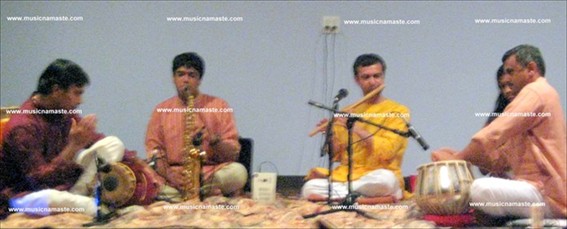Sax and flute Jugalbandi Concert
Jul 17 2009
Grapevine, TX
The tradition of “Jugalbandi” is an age old one, where two skilled musicians, playfully challenge each other with various improvisations. This duet could be instrumental or vocal and is usually seen between Carnatic and Hindustani styles of music. Think of it as two creepers that entwine with each other, each with its own distinct fragrance and unique beauty. Yet as they entwine they bring forth such a unified aesthetic appeal, that one is simply mesmerized in the beauty of it
This was exactly how I felt in the “Jugalbandi” concert of saxophone and flute performed by Shyam Murali and Nilendu Jain.
The concert team was as follows –
Shyam Murali on saxophone, Carnatic style
Nilendu Jain on flute, Hindustani style
Bala Murali on “Mridangam” (Carnatic percussion)
Neel Bhatt on “Tabla” (Hindustani percussion)
Megna Murali (Vocal Carnatic)
The concert was arranged by Bruce Rosenstiel in association with Teresa Lieberman

Jugalbandi Concert
The concert began with a vocal rendering of “Gajanananayutham Ganeshwaram” by Megna Murali. This composition is set to “Raaga Chakravaka” and “Taala Adi”. This was accompanied by Bala Murali on “Mridangam” and Shyam Murali on saxophone.
The “Jugalbandi” part of the concert commenced with a beautiful rendering of “Raaga Mohana” on saxophone by Shyam Murali. He was soon joined on the flute by Nilendu Jain. Both musicians commendably brought out the beauty of “Raaga Mohana” (“Raag Bhupali” in Hindustani). As they explored the Raaga, layer by layer, the waves of the glorious music soon transported me into the “Vrindavan” gardens. I was truly amazed. I wondered if this why they say that music can be transcendental.
The Hindustani name for “Raaga Mohana” is “Raag Bhupali”. As explained later by Shyam Murali, “Raaga Mohana” is a pentatonic “Raaga”. It is an evening or an early night Raaga .i.e. its power is truly realized when listened to or performed in the evenings.
The next composition was set to “Raaga Chandrakauns”. This again is a night time “Raaga”. A great “Jugalbandi” followed between the sax and the flute.
The last piece before the break was a Gujarati “Bhajan” – “Vaishnav jan to” rendered by Nilendu Jain on flute, accompanied by Neel Bhatt on Tabla. This is a moving piece which as explained by Nilendu was Mahathma Gandhi’s favorite.
I must say that the audience was very receptive and inquisitive about the Indian styles of music, and the instruments. The artists explained to the audience the basic concepts of Indian classical music. Basic concepts of Hindustani and Carnatic music were explained. The concepts of Raaga and Taala were discussed. This is great way to connect the music with the audience and simplify it for them.
[To learn more about the origin of Indian classical music visit – . To learn the basic concepts of Raaga, Taala, visit]
After the break the concert resumed with Megna Murali’s rendition of the composition “Amba Mamava” set in 3 lilting “Raagas” – “Ranjani”, “Niranjani” and “Janaranjani”. The key challenging aspect in such type of composition is transitioning across the three “Raagas” – back and forth and Megna Murali did it effortlessly.
The next part of the “Jugalbandi” was a treat, with wonderful improvisations and beautiful emulations. It was set to “Raaga Charukesi”. As explained by Shyam Murali this is a complete “Raaga” with all seven notes. This composition was set to 9 beats cycle.
The concluding piece of the performance was an open playground for the percussionists. The audience greatly applauded the powerful performance of Bala Murali on the “Mridangam” and Neel Bhatt on “Tabla”.
To sum it all up, the concert was a great experience for me. I have mostly attended Carnatic style concerts, and hence this concert gave me an opportunity of knowing Hindustani music and relating it to the Carnatic style. The selection of “Raagas” seemed very appropriate.
Saxophone in the Carnatic music scene is relatively newer. Incorporating it in Carnatic music was accomplished by Kadri Gopalanath. I share one commonality with Kadri Gopalanath and it is that we come from the same place. I practically grew up listening to Kadri Gopalanath’s saxophone. No wedding or religious event began without the beautiful “Mangala Vadya” from Kadri Gopalanath’s saxophone. I have not yet had the opportunity to listen to him live. But I am immensely happy to have seen his student Shyam Murali’s performance.
It is admirable of Bruce Rosenstiel and Teresa Lieberman for taking up this wonderful initiative to treat the music enthusiasts.
Nilendu Jain performed with great depth, technique and melody on the flute. His notes on “Raag Bhupali” gave me visions of “Vrindavan”. Neel Bhatt’s Tabla performance came across with immense vigor and vitality.
The Murali family truly shone on the stage with Carnatic classical performance! Megna Murali is a gifted performer with a great voice. Shyam Murali was superb on the saxophone. He delivers the “Raagas” with great skill and ingenuity. Bala Murali is a pro on the Mridangam. It takes years of dedication and commitment to achieve expertise in classical music. And to see an entire family so immensely dedicated to music, championing it at every opportunity is exceptional.
MusicNamaste wishes the entire team all the very best!